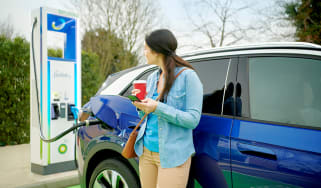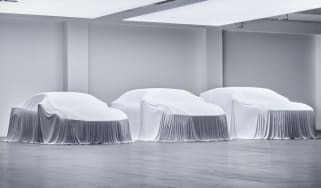What to know to use an electric campervan.
If you’re afraid to drive electric, on this page, we want to show you how easy it is in Norway.
First of all, we want to tell you that in Norway, more than half of the vehicles are electric, and soon all of them will be, so there are more charging stations for electric vehicles than for fossil fuels.
Just have a look at this link https://chargefinder.com/en and you will see that Norway has plenty of charging stations. They are all over the country.

Charging points around Bergen area.
How to drive a car to avoid high expenses
Driving an electric vehicle (EV) efficiently can significantly reduce usage costs and maximize battery life. Here are some tips for more efficient driving:
- Smooth Start and Gradual Acceleration: Rapid acceleration consumes more energy, so it’s better to accelerate gradually. Use the Eco mode if your vehicle has it, as it limits the throttle response to reduce consumption.
- Maintain a Steady Speed: When driving on the highway, maintaining a constant speed, preferably within legal limits, will help save energy.
- Plan Your Routes: Avoid routes with heavy traffic and avoid queuing whenever possible, as frequent stops and slow traffic can negatively affect efficiency.
- Anticipate Braking: When approaching a red light or a traffic signal, gradually reduce speed instead of braking abruptly. This allows regenerative braking to convert kinetic energy into electrical energy, which is stored in the battery.
- Use One-Pedal Driving Mode: Some electric vehicles have a driving mode that allows you to drive using only the accelerator pedal. When you lift your foot off the pedal, the vehicle automatically slows down. This can help save energy and extend brake life.
- Monitor Use of Air Conditioning/Heating: Electric air conditioning and heating can consume a significant amount of energy. Use them sparingly or adjust the temperature to reduce consumption.
- Optimize Tyre Pressure: Under-inflated tires can increase rolling resistance and thus energy consumption. Keep tires inflated to the pressure recommended by the manufacturer.
- Plan Your Charges: If possible, charge your vehicle at times when electricity is cheaper, such as at night. Also, avoid charging the battery to 100% if it’s not necessary, as it can cause premature wear.
By adopting these driving practices, you can maximize the efficiency of your electric vehicle and reduce energy usage. This can not only save you money in the long run but also help reduce your environmental impact.
USE OF THE VEHICLE (info about the rental)
Upon receiving the vehicle in optimal condition for rental purposes, the lessee is entrusted with operating and maintaining it in strict adherence to traffic regulations. The provided vehicle comes fully equipped with requisite documents, tyres, tools, and accessories. Prohibited actions include:
- Permitting unauthorized individuals to operate the vehicle.
- Engaging in subleasing without explicit consent for transporting people or goods.
- Operating the vehicle under the influence of alcohol, drugs, fatigue, or illness.
- Using the vehicle for pushing or towing other vehicles.
- Inadequately parking or leaving the vehicle unattended.
- Traveling outside the national road network or unsuitable terrain, with damages resulting from improper operation excluded from insurance coverage.
- Failing to promptly report and address vehicle malfunctions or anomalies.
Any breach of these conditions may result in the lessee assuming responsibility for associated penalties.
RETURN OF THE VEHICLE
The lessee is obligated to return the rented vehicle, along with all associated documents, keys, tires, tools, and accessories, at the agreed-upon location and date. Any alterations to this arrangement must be authorized in writing by the lessor, with failure to comply empowering the lessor to pursue legal action for the vehicle’s return.
CHARGES FOR THE RENT
The lessee is responsible for payment related to:
- Exceptional services are outlined in Annex I.
- Charges for loss of vehicle documentation, tires, tools, accessories, etc.
- Costs of repairing damages resulting from accidents, subject to specified conditions.
- Fines and legal expenses arising from traffic violations by the lessee.
- Expenses related to incorrect refuelling, with the lessee covering all associated costs.
FUEL/EL Charging Station
The vehicle is delivered with a full tank of Type O gas. Charging is facilitated using CCS.
ACCIDENTS
In the event of an accident, the lessee commits to gathering complete information, filling out an accident report within 48 hours, and promptly notifying the lessor.
RESPONSIBILITY OF THE LESSOR
While the lessor takes precautions against mechanical failures, it assumes no responsibility for damages resulting from such failures.
CHARGES IN CREDIT CARDS
The lessee authorizes Campervan Bergen AS/Elcampervan AS to charge agreed amounts or pending fees to their credit card, covering rent, uninsured damages, or other attributable charges.
ROAD ASSISTANCE INSURANCE
The rental contract includes roadside assistance.
TRANSPORT AND COLLECTION OF THE VEHICLE IN DIRECTION OTHER THAN THE HABITUAL
Transporting the vehicle to an alternate address requires prior consent and payment for the service.
REQUIREMENT FOR THE DRIVER
The lessee and driver must meet specific criteria, including a valid driver’s license, age requirement, and proof of identification.
PROTECTION OF PERSONAL DATA
Personal data will be processed according to current regulations, necessary for the commercial relationship.
GUEST RECOMMENDATION
The guest should document the vehicle’s exterior through video or photos before rental, serving as evidence in case of damages upon return.

If you’ve ever stopped at a charging station, you may have noticed a number of charging-cable options available for electric vehicles. This is because electric vehicles (EVs) and plug-in hybrid electric vehicles (PHEVs) can’t all be charged by a single standard of plug or charging speed – or at least not yet.
Hence, stations often feature different connectors to suit different cars and charging requirements. One of these connectors is the CHAdeMO or CCS standard, a rapid-charging DC connector that features on some models.. Rapid charging is the quickest way of recharging the batteries in electric cars.
Info about CCS charging.
CCS, which stands for Combined Charging System, is a type of electric vehicle (EV) charging standard. It is designed to support both direct current (DC) fast charging and alternating current (AC) charging, providing a versatile and efficient charging solution for electric vehicles. CCS is widely used in Europe and North America and has become one of the most prevalent fast-charging standards.
Here are key points about CCS charging that may be helpful for potential customers:
- Two-in-One Solution: CCS integrates both AC and DC charging into a single connector, allowing EVs to be charged with either AC or DC power. This flexibility enables compatibility with a variety of charging stations.
- Fast Charging Capability: One of the primary advantages of CCS is its support for DC fast charging. This allows electric vehicles to recharge their batteries quickly, making it convenient for drivers on longer journeys.
- High Power Levels: CCS supports high power levels, allowing for faster charging rates. This is especially beneficial for reducing charging time and improving the overall convenience of electric vehicles.
- Compatibility: Many electric vehicles, especially those from European and North American manufacturers, are equipped with CCS connectors. This widespread adoption makes it easier for EV owners to find compatible charging stations.
- Plug Types: The CCS plug has two parts – the top part is the AC connector, and the bottom part is the two-pin DC connector. For AC charging, the top part is used, and for DC fast charging, both parts are used.
- Backward Compatibility: CCS is designed to be backwards compatible with the existing Type 2 AC charging infrastructure. This means that CCS-equipped vehicles can still use AC charging stations with Type 2 connectors.
- Charging Stations: CCS charging stations are commonly found at public charging networks, including highways, shopping centers, and urban locations. They are an integral part of expanding the electric vehicle charging infrastructure.
For potential customers considering an electric vehicle, it’s important to check whether the vehicle supports CCS charging and to be aware of the availability of CCS charging stations in their region for convenient and efficient charging.
More info about CCS
What is CCS?
To understand what CCS is, you first need to understand how rapid charging works. There are several different speeds at which EVs and PHEVs can be charged. They start at low charging rates of 2 or 3kW from a three-pin socket at home, rising to a 7kW rate for more advanced ‘wallbox’ charging units. Some home and public charging units also feature a faster 22kW charging rate; these are known as fast chargers. The more power a charger supplies, the faster the car’s batteries are topped up.
Then there are rapid-charging stations. Thanks to advances in battery and charging technology, these stations can supply electricity much faster. Rapid AC stations work at 43kW, while rapid DC stations supply power at 50kW or more – frequently 150kW or even 350kW these days.
The key here is that electric vehicles use DC (direct current) to power the motor, while the electric grid in the UK supplies AC (alternating current). When charging from a home AC charger, the electric vehicle’s internal converter (rectifier) turns AC power into DC, which the car is then able to use. Rapid DC chargers do the conversion in the charging booth. This means the charging station directly supplies the vehicle with DC power, without the need to first convert the power from AC to DC.
CCS is a rapid-charging DC standard, established by Toyota, Nissan, Mitsubishi and other Japanese companies in 2010. It’s an abbreviation of the words Charge de Move. The idea was to create a charging standard that would be adopted across the automotive industry, as well as other sectors relying on electrical DC charging. It became the first-ever fast-charging platform for electric vehicles, and now enables ranges from 6kW to 150kW – although the maximum available for electric vehicles at the moment is 50kW.
Which cars currently work with CCS?
As CCS was created by Nissan, Mitsubishi, Toyota, Fuki and Tokyo Electric Power Company, Japanese carmakers are some of the biggest adopters of CCS technology. In the UK, the cars that can be rapidly charged with a CCS connector include the Nissan Leaf, Mitsubishi Outlander PHEV, Toyota Prius Plug-In, Tesla Model S (when fitted with an adapter), Nissan e-NV200, Kia Soul EV Mk1, Citroen Berlingo Electric Mk1, Citroen C-Zero and the LEVC London Taxi.
The Combined Charging System (CCS) Standard: A Unified Vision for EV Charging Ecosystem
In the evolving world of electric vehicles (EVs), the Combined Charging System (CCS) standard plays a pivotal role, driving towards an enhanced charging ecosystem with its aim of facilitating accessibility and interoperability. Across the EV industry, it has become clear that unified standards and protocols for EV charging and communication are indispensable for the success of various stakeholders involved in this revolution.
The development of the CCS standard began to take shape in 2011 when two leading automotive associations, SAE International (Society of Automotive Engineers) and the European Automobile Manufacturing Association (ACEA), put forth the proposal. This initiative aimed to amalgamate existing standards, such as the J1772 for Level 1 or Level 2 AC-powered charging, with a two-pin connector for high-speed DC charging. Seven prominent manufacturers, including Audi, BMW, Daimler, Ford, General Motors, Porsche, and Volkswagen, enthusiastically embraced this combined plug standard. The first prototype demonstrating the CCS was showcased in May 2012, marking a significant step towards standardization.
At the core of the CCS system are the «combo plugs» – CCS Combo 1 (CCS1) and CCS Combo 2 (CCS2). CCS1 utilizes the SAE J1772 plug for AC connection, while CCS2 follows the EU-style plug for a 3-phase AC connection. Both, however, leverage the same connector for DC charging. The standardization doesn’t stop here; it encompasses various facets of EV charging, including communication between the station and vehicle, load balancing, authentication, and the vehicle coupler. The overarching goal is to ensure seamless interaction and compatibility across the charging infrastructure.
In terms of geographical adoption, the progress has been noteworthy. In North America, the CCS1 standard dominates the market, extending from the U.S. and Canada to regions like Central America, Korea, and Taiwan. Meanwhile, CCS2 has emerged as the norm in Europe and is mandatory for charging networks within the EU. This standard is also embraced across various other continents and countries, including Greenland, Iceland, South America, South Africa, Arabia, India, Singapore, Taiwan, Hong Kong, Oceania, and Australia. In regions where no specific standard has been chosen, CCS2 remains the recommended choice by CharIN (Charging Interface Initiative), showcasing its global appeal.
A significant development in the North American market is the introduction of the North American Charging Standard (NACS) by Tesla. This innovative system, which encompasses both AC and DC charging capabilities within a single plug, is expected to coexist with the CCS for a considerable time. Tesla’s formidable presence and its expansive DC charging network make the NACS a formidable player in the market. Other major manufacturers, such as Ford, General Motors, Rivian, Volvo, Polestar, and Mercedes-Benz, have announced plans to incorporate the NACS charge port in their EVs for the North American market, further solidifying its position.
However, despite the emergence of NACS, CCS remains resilient in North America. The federal infrastructure funding, totaling $7.5 billion, incentivizes the adoption and support of CCS by EV charging networks. Notably, Tesla has committed to opening up a substantial number of its Superchargers to non-Tesla vehicles, thereby enhancing accessibility. This move underscores the commitment of charging providers to cater to the diverse needs of EV drivers, ultimately ensuring a smooth and holistic charging experience.
In Europe and several other countries, the dominance of CCS2 epitomizes the vision of interoperability and accessibility. Even Tesla’s charging infrastructure in Europe adheres to the CCS2 standard, highlighting the industry’s drive towards harmonization. In the U.S., the simultaneous support for both CCS and NACS by public charging networks symbolizes the cooperative and adaptive nature of the EV charging landscape. This approach benefits EV drivers, providing them with a broader range of charging options and ensuring a seamless experience across different charging stations.
In conclusion, the journey towards a standardized and interoperable EV charging ecosystem has been marked by significant strides, propelled by initiatives like CCS and NACS. These standards have not only simplified the EV charging process but have also set the stage for future innovations and advancements. As the world transitions towards a greener and more sustainable future, the CCS standard will continue to serve as a cornerstone, enabling seamless connectivity and accessibility for EV drivers globally.
Is CHAdeMO the only rapid-charging standard?
If you’re using the charging type filter on Zap-Map, you’ll note that all charging stations with a CHAdeMO connector also feature a CCS rapid-charging connector. This is a competing rapid DC connector standard developed by various German carmakers. It stands for Combined Charging System and was introduced in 2012 by Volkswagen, Audi, BMW, Mercedes, General Motors, Ford, Daimler, and Porsche.
The CCS standard has become much more popular than CHAdeMO in Europe, as car makers such as VW, BMW and Mercedes continue to introduce new electric models to the market. More recently introduced models from Asian brands, such as the Hyundai Kona Electric, use the CCS charging standard, too. It has rapidly become the standard for almost all electric cars in Europe, outcompeting CHAdeMo in the process.
Should I specifically look out for cars with either CCS or CHAdeMO connector capability?
This depends on whether you want access to rapid charging or not. If you’re happy being able to charge at lower speeds, and taking a longer time to top up your vehicle, then you won’t necessarily need a car with either CCS or CHAdeMO connector capability. A 7kW Type 2 charger can easily top up a car overnight, and if the electric vehicle is used only for small trips each day, there is little need to invest in one that can rapid charge. At the moment, all rapid-charging stations come with both a CCS and CHAdeMO connector, so choosing a vehicle based on whether it has one or the other isn’t necessary.
- CARS
- CHARGING
RECOMMENDED
Complete guide to the BP Pulse (formerly Polar Plus) charging network
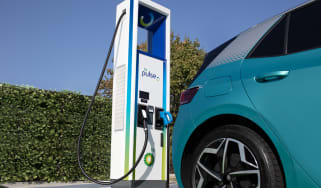
Complete guide to the BP Pulse (formerly Polar Plus) charging network
How much does it cost to charge an electric car?
How much does it cost to charge an electric car?
Complete guide to the Gridserve (formerly Ecotricity) Electric Highway charging network
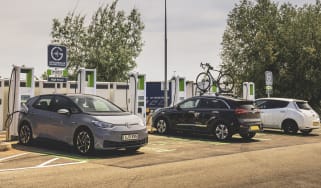
Complete guide to the Gridserve (formerly Ecotricity) Electric Highway charging network
Complete guide to the Fastned electric-car charging network in the UK
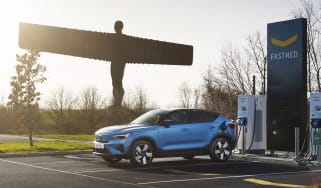
Complete guide to the Fastned electric-car charging network in the UK
MOST POPULAR
Fisker PEAR: first look at £25,000 electric city car

Fisker PEAR: first look at £25,000 electric city car

